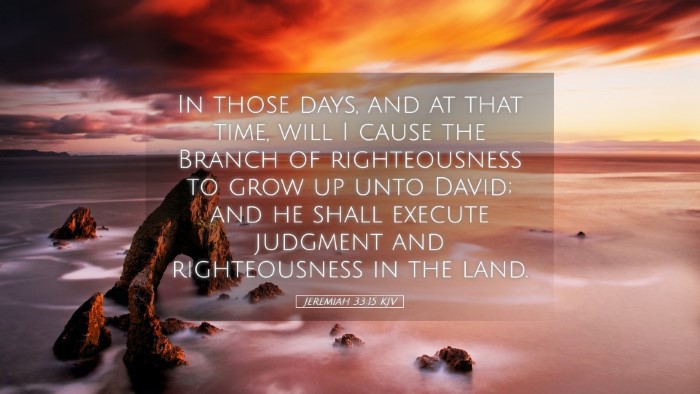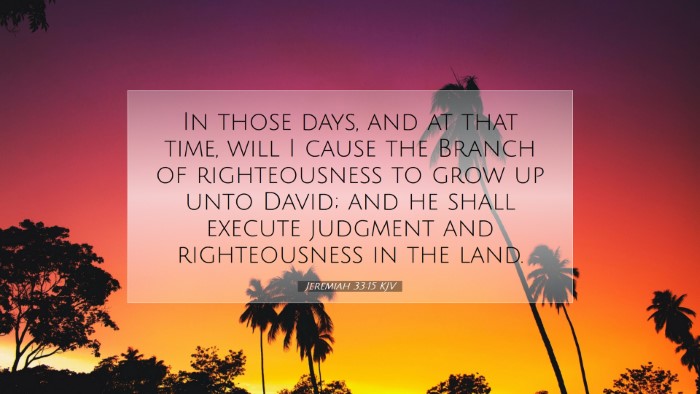Commentary on Jeremiah 33:15
Jeremiah 33:15 states: "In those days, and at that time, will I cause the Branch of righteousness to grow up unto David; and he shall execute judgment and righteousness in the land." This verse is rich with theological implications and prophetic significance, foretelling the coming of a righteous ruler from the lineage of David, known as the Branch. Below, we explore the thoughts of several notable public domain commentaries.
Contextual Background
This passage is located within a broader context of restoration and hope given to the people of Israel during a time of great turmoil and impending judgment. Jeremiah, often called the "weeping prophet," conveyed God’s messages of both impending judgment for sins and the future restoration of His people. In the preceding chapters, there is a recurrent theme of God promising to restore His people and reestablish His covenant with Israel.
The Significance of "The Branch"
Matthew Henry elucidates that "the Branch" signifies not only a sprout from the tree of David but is emblematic of the Messiah, who will arise from this lineage. He emphasizes that this promise instills hope in the hearts of the Jewish people, assuring them that despite their current exile and judgment, God's covenant with David remains intact.
- Symbol of Restoration: The image of "the Branch" conveys renewal and life flourishing out of what appears to be a withered and desolate situation.
- Connection to David: Jeremiah’s mention of David connects to the Davidic Covenant wherein God promises an everlasting kingdom through his lineage.
Messianic Expectation
Albert Barnes contextualizes this prophecy as one of the clearest anticipations of the Messiah in the Old Testament. He notes that this prophecy culminates in its fulfillment in Jesus Christ, who is often referred to as “the Branch” in the New Testament:
- Righteous Leadership: The verse speaks of judgment and righteousness, character traits that define the rule of the Messiah, contrasting sharply with the leaders of Israel during Jeremiah’s time, who failed in these areas.
- Eschatological Fulfillment: Barnes observes that the prophecy not only points to Christ’s first coming but also has implications for eschatological hope, wherein Christ reigns eternally.
The Character of the Ruler
Adam Clarke provides insights into the characteristics of the ruler described in this verse. He emphasizes that this leader, stemming from David, will execute both judgment and righteousness:
- Judgment: The execution of judgment speaks to the divine justice that will characterize His rule, ensuring that the oppressed will be vindicated and justice upheld.
- Righteousness: Clarke asserts the importance of righteousness within the governance of Israel, highlighting that the moral integrity of this ruler will inspire the nation to align with God’s statutes.
Theological Implications
The profound theological implications of Jeremiah 33:15 reveal God’s unwavering commitment to His people. It underscores the themes of hope amidst despair, divine justice, and the fulfillment of God's promises:
- Covenant Faithfulness: This verse serves as a reminder of God's covenant faithfulness, wherein He reassures His people that despite their failures, He will bring forth a righteous leader to shepherd them.
- Hope in Desperation: For pastors and theologians, this text is a potent reminder to communicate hope to believers in times of exile or despair, pointing them towards Christ, the ultimate fulfillment of these promises.
Contemporary Application
In contemporary application, Jeremiah 33:15 calls the church today to recognize Christ as the ultimate authority and standard of justice and righteousness. It provides a framework for understanding God’s redemptive plan through history:
- Modeling Righteous Leadership: Leaders within the church are encouraged to emulate these qualities of righteousness and justice in their ministry.
- Hope for the Future: This passage assures the church of God's promise to restore and bring about a new creation, further encouraging believers to trust in God's redemptive plan.
Conclusion
In conclusion, Jeremiah 33:15 serves as a profound declaration of God’s future redemptive work through the messianic line of David. It is a reminder of God's promise to restore and reign in righteousness. As scholars, pastors, and students of the Word examine this text, they are called not only to understand its historical context and prophetic implications but also to apply its truths in their lives and ministries today.


